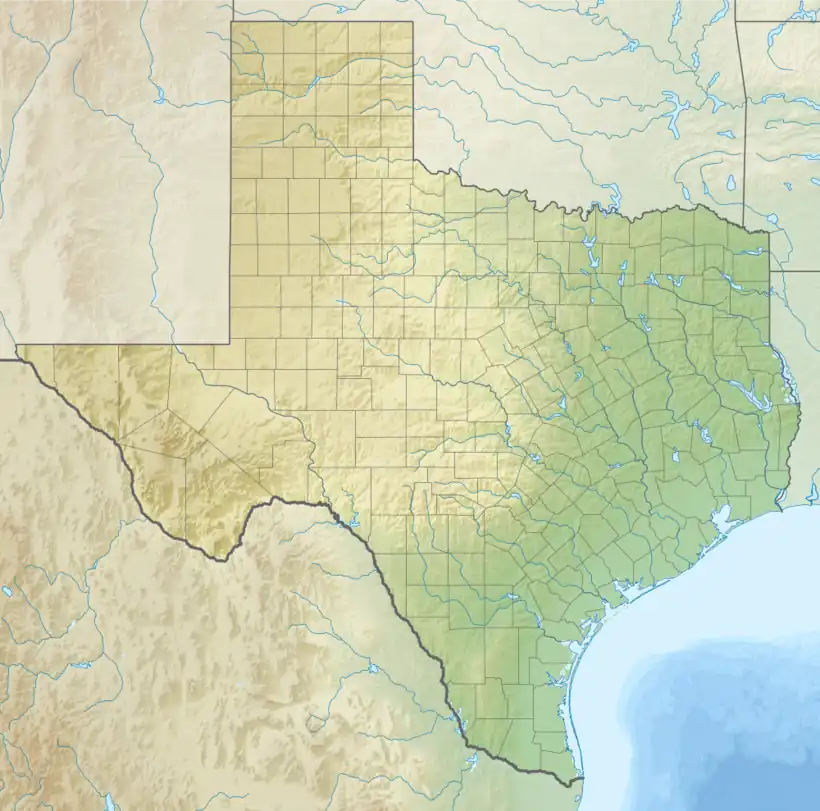| Hueco Formation | |
|---|---|
| Stratigraphic range: | |
| Type | Formation |
| Underlies | Wilkie Ranch Formation |
| Overlies | Panther Seep Formation |
| Thickness | 5,000 feet (1,500 m) |
| Lithology | |
| Primary | Limestone |
| Other | Shale, sandstone |
| Location | |
| Coordinates | 31°57′11″N 106°01′37″W / 31.953°N 106.027°W |
| Region | Texas |
| Country | United States |
| Type section | |
| Named for | Hueco Mountains |
| Named by | G.B. Richardson |
| Year defined | 1904 |
 Hueco Formation (the United States)  Hueco Formation (Texas) | |
The Hueco Formation is a geologic formation in west Texas and southern New Mexico.[1][2][3] It preserves fossils dating back to the early Permian period.[4][5]
Description
The formation is composed most of massive gray fossiliferous limestone with some shale and sandstone, with a thickness in excess of 5,000 feet (1,500 m). It overlies the Panther Seep Formation[6] with a slight disconformity, and its base is typically a thick biostromal limestone bed.[7] The formation unconformably underlies the Wilkie Ranch Formation.[8] It intertongues with the Abo Formation in the southern San Andres Mountains.[5]
In the Robledo Mountains, the Hueco is promoted to group rank and divided into (in ascending stratigraphic order) the Shalem Colony, Community Pit, Robledo Mountains, and Apache Dam Formations.[9] In the Hueco Mountains, the uppermost formation is the Alacran Mountain Formation.[10]
The Hueco Formation is contemporary with the Abo Formation and represents continued marine sediment deposition south of the prograding Abo deltas.[7]
History of investigation
The formation was first defined by G.B. Richardson in 1904, but mistakenly thought to be Pennsylvanian in age.[1] Nelson dated the formation as earliest Permian in the Franklin Mountains in 1940.[4] Spencer G. Lucas et al. promoted the formation to group rank in 1998.[9]
See also
Footnotes
References
- Cys, J.M. (1976). "Wilkie Ranch Formation, new Permian unit in Finlay Mountains, West Texas". American Association of Petroleum Geologists Bulletin. 60 (7): 1107–1110. doi:10.1306/C1EA3627-16C9-11D7-8645000102C1865D.
- Bachman, G.O.; Hayes, P.T. (1958). "Stratigraphy of Upper Pennsylvanian and Lower Permian rocks in the Sand Canyon area, Otero County, New Mexico". Geological Society of America Bulletin. 69 (6): 689–700. Bibcode:1958GSAB...69..689B. doi:10.1130/0016-7606(1958)69[689:SOUPAL]2.0.CO;2.
- Kelley, S.; Matheny, J.P. (1983). "Geology of Anthony quadrangle, Dona Ana County, New Mexico". New Mexico Bureau of Mines and Mineral Resources Geologic Map. 54. Retrieved 20 September 2020.
- Kues, B.S.; Giles, K.A. (2004). "The late Paleozoic Ancestral Rocky Mountain system in New Mexico". In Mack, G.H.; Giles, K.A. (eds.). The geology of New Mexico. A geologic history: New Mexico Geological Society Special Volume 11. pp. 95–136. ISBN 9781585460106.
- Lucas, Spencer G.; Heckert, Andrew B.; Estep, John W.; Cook, Casey W. (1998). "Stratigraphy of the lower Permian Hueco Group in the Robledo Mountains, Dona Ana County, New Mexico" (PDF). New Mexico Museum of Natural History Bulletin. 12. Retrieved 4 August 2020.
- Nelson, L.A. (1940). "Paleozoic stratigraphy of the Franklin Mountains, West Texas". American Association of Petroleum Geologists Bulletin. 24 (1): 157–172. doi:10.1306/3D93319A-16B1-11D7-8645000102C1865D.
- Richardson, G.B. (1904). "Report of a reconnaissance in Trans-Pecos Texas north of the Texas and Pacific Railway". University of Texas Mineral Survey Bulletin. 9. hdl:2152/24408. Retrieved 19 September 2020.
- Richardson, G B. (Jun 1908). "Paleozoic Formations in Trans-Pecos Texas". American Journal of Science. 25 (150): 474. Bibcode:1908AmJS...25..474R. doi:10.2475/ajs.s4-25.150.474. Retrieved 20 September 2020.
- Richardson, G.B. (1914). "Description of the Van Horn quadrangle, Texas". U.S. Geological Survey Geologic Atlas of the United States. Van Horn folio (194).
- Williams, T.E. (1963). "Fusulinidae of the Hueco Group (Lower Permian), Hueco Mountains, Texas". Peabody Museum of Natural History Bulletin. 18.